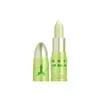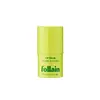What's inside
What's inside
 Key Ingredients
Key Ingredients

 Benefits
Benefits

 Concerns
Concerns

 Ingredients Side-by-side
Ingredients Side-by-side

Polybutene
Hydrogenated Polyisobutene
EmollientDicalcium Phosphate
AbrasiveOctyldodecanol
EmollientPolyethylene
AbrasiveCaprylic/Capric Triglyceride
MaskingHydrogenated Poly(C6-14 Olefin)
EmollientMicrocrystalline Wax
Emulsion StabilisingSynthetic Wax
AbrasiveStearalkonium Bentonite
Gel FormingMica
Cosmetic ColorantPropylene Carbonate
SolventEthyl Vanillin
MaskingCannabis Sativa Seed Oil
EmollientPentaerythrityl Tetra-Di-T-Butyl Hydroxyhydrocinnamate
AntioxidantCI 77492
Cosmetic ColorantCI 42090
Cosmetic ColorantPolybutene, Hydrogenated Polyisobutene, Dicalcium Phosphate, Octyldodecanol, Polyethylene, Caprylic/Capric Triglyceride, Hydrogenated Poly(C6-14 Olefin), Microcrystalline Wax, Synthetic Wax, Stearalkonium Bentonite, Mica, Propylene Carbonate, Ethyl Vanillin, Cannabis Sativa Seed Oil, Pentaerythrityl Tetra-Di-T-Butyl Hydroxyhydrocinnamate, CI 77492, CI 42090
Caprylic/Capric Triglyceride
MaskingPolybutene
Polyethylene
AbrasiveIsononyl Isononanoate
EmollientOctyldodecanol
EmollientMicrocrystalline Wax
Emulsion StabilisingSynthetic Wax
AbrasiveStearalkonium Hectorite
Gel FormingCaprylyl Glycol
EmollientPropylene Carbonate
SolventGlyceryl Laurate
EmollientGlyceryl Undecylenate
EmollientTocopheryl Acetate
AntioxidantCocoyl Hydrolyzed Collagen
CleansingSodium Hyaluronate
HumectantWater
Skin ConditioningButylene Glycol
HumectantWine Extract
AntioxidantRose Extract
Skin ConditioningSucrose
Humectant1,2-Hexanediol
Skin ConditioningCaprylic/Capric Triglyceride, Polybutene, Polyethylene, Isononyl Isononanoate, Octyldodecanol, Microcrystalline Wax, Synthetic Wax, Stearalkonium Hectorite, Caprylyl Glycol, Propylene Carbonate, Glyceryl Laurate, Glyceryl Undecylenate, Tocopheryl Acetate, Cocoyl Hydrolyzed Collagen, Sodium Hyaluronate, Water, Butylene Glycol, Wine Extract, Rose Extract, Sucrose, 1,2-Hexanediol
Ingredients Explained
These ingredients are found in both products.
Ingredients higher up in an ingredient list are typically present in a larger amount.
This ingredient is an emollient, solvent, and texture enhancer. It is considered a skin-softener by helping the skin prevent moisture loss.
It helps thicken a product's formula and makes it easier to spread by dissolving clumping compounds.
Caprylic Triglyceride is made by combining glycerin with coconut oil, forming a clear liquid.
While there is an assumption Caprylic Triglyceride can clog pores due to it being derived from coconut oil, there is no research supporting this.
Learn more about Caprylic/Capric TriglycerideMicrocrystalline Wax is created by de-oiling petroleum. It is highly refined and purified before being added to cosmetics.
Microcrystalline Wax is used to enhance the texture and create even consistency. It helps stabilize a product by preventing ingredients from separating.
Octyldodecanol is a fatty alcohol. It is primarily used to enhance the texture of products.
As an emulsifier, Octyldodecanol helps prevent the oils and waters from separating. It also prevents ingredients from creating foam when shaken.
Octyldodecanol is created by reducing fatty acid to an alcohol.
Due to its high molecular weight, it does not get absorbed into the skin.
Learn more about OctyldodecanolPolybutene is used to help control the viscosity of a product. This just means it helps adjusts the texture.
It is a polymer and does not get absorbed into the skin due to its large size.
Studies found this ingredient did not irritate skin in concentrations below 15%.
Learn more about PolybutenePolyethylene is a synthetic ingredient that helps the skin retain moisture. It is a polymer.
It is also typically used within product formulations to help bind solid ingredients together and thicken oil-based ingredients. When added to balms and emulsions, it helps increase the melting point temperature.
This ingredient is a solvent. It helps dissolve active ingredients and alter the texture of products.
Propylene Carbonate is commonly used in makeup and with clay, such as montmorillonite or bentonite.
Studies show this ingredient to be safe for cosmetics. When it is undiluted, it can cause skin irritation. (It is always diluted in skincare and makeup). This ingredient is water-soluble.
Propylene Carbonate is created from propylene glycol and carbonic acid.
Learn more about Propylene CarbonateSynthetic Wax is created from fossil fuels such as natural gas. It is used to enhance texture, adjust pH, and as an occlusive.
It may also be used as an abrasive ingredient to exfoliate the skin.
Synthetic Wax may not be fungal acne safe.
Learn more about Synthetic Wax